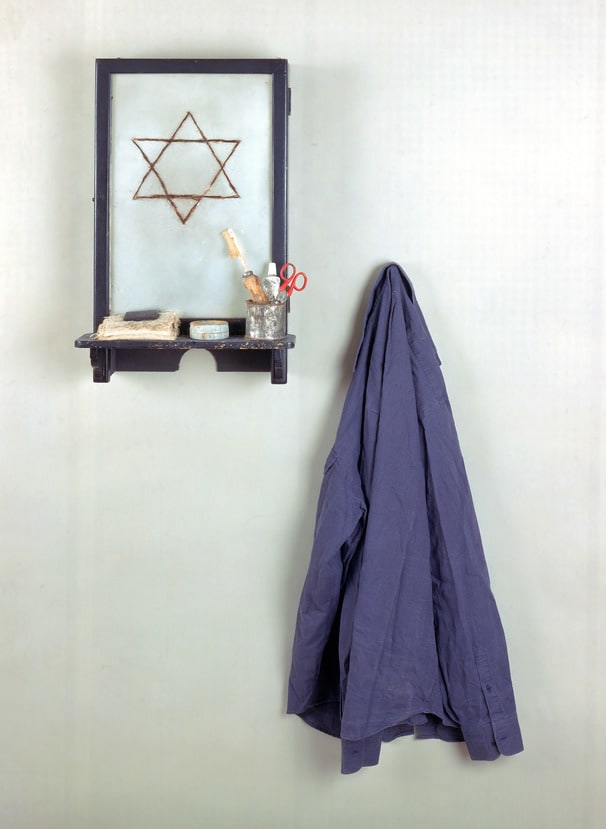
- Artist/Maker:
- Fabio Mauri
- Bio:
- Italian, 1926-2009
- Title:
- Small Closet with Shirt
- Portfolio/Series:
- Ebrea
- Date:
- 1971
- Medium:
- Mixed media and hair
- Dimensions:
- Dimensions variable
- Credit Line:
- Purchase: Dr. Jack Allen and Shirley Kapland Fund
- Accession Number:
- 2000-18a-e
Not On View
A young woman, Ebrea, walks into the area, approaches the mirror, and removes her clothes. With haunting deliberateness, she repeats her ritual: standing naked in front of the medicine cabinet and mirror, the young woman slowly cuts her hair with a small pair of scissors and, rolling it into threads with glue, attaches the pieces to the mirror. Her actions gradually form a Star of David. The cutting of the hair, the prominent star, and the shirt, reminiscent of a concentration-camp uniform, remind the viewer of the indignities suffered by Jews during the Holocaust. Small Closet with Shirt is the focal point of Ebrea, Fabio Mauri's large installation and his most famous performance work, which was first staged in Venice in 1971 and revived at the 1993 Venice Biennale.
For the non-Jewish Mauri, who came of age in post-World War II Italy, the specter of the Holocaust has determined his core artistic vision. This moral imperative has been inflected by the minimalist aesthetics and theatricality of the Arte Povera movement from which Mauri's work emerged. Arte Povera was a politically motivated effort to break down the barrier between art and life, the equivalent of the neo-Dadaist and Fluxus happenings in the 1960s in the United States. The lack of preciousness of Small Closet with Shirt, for example, is consistent with other components of Ebrea, whose commonness, yet dramatic isolation, underscores the political opposition of Arte Povera to the elitism of the fine arts.
Another part of Ebrea is the Western Wall, with its iconic construction of the old leather suitcases. Referring directly to the Wailing Wall in Jerusalem, the vestiges of Solomon's Temple, this part of Ebrea also alludes to the ideals and faith of a people, here symbolized by the remnants of individuals who were uprooted, incinerated, but who remain. Around the wall are placed simulated artifacts of the kind that constituted the economy of the death camps-human by-products: skin, hair, leather, soap-each bearing a label onto which the word "Jewish" is written next to the name of the object in question.
In light of such historical identification and the feeling, as he puts it, of "unconsummated lament," twentieth-century Europe's scourge of antisemitism has served as Mauri's paradigm for all kinds of ethnic, religious, and sexual oppression that persist in the world. It was the artist's sense that his country had begun to demonstrate an increasing ambivalence toward history and a will to forget its fascist past that impelled him to create Ebrea initially, and to revive it in 1993 in the wake of the civil war and genocide in former Yugoslavia. Beyond the need to reenact the horror of the past, what informs and pervades Mauri's work as a whole is the continuing presence of ethnic intolerance throughout the world and the universally alarming tendency to forget how easily such behavior can become endemic.
For the non-Jewish Mauri, who came of age in post-World War II Italy, the specter of the Holocaust has determined his core artistic vision. This moral imperative has been inflected by the minimalist aesthetics and theatricality of the Arte Povera movement from which Mauri's work emerged. Arte Povera was a politically motivated effort to break down the barrier between art and life, the equivalent of the neo-Dadaist and Fluxus happenings in the 1960s in the United States. The lack of preciousness of Small Closet with Shirt, for example, is consistent with other components of Ebrea, whose commonness, yet dramatic isolation, underscores the political opposition of Arte Povera to the elitism of the fine arts.
Another part of Ebrea is the Western Wall, with its iconic construction of the old leather suitcases. Referring directly to the Wailing Wall in Jerusalem, the vestiges of Solomon's Temple, this part of Ebrea also alludes to the ideals and faith of a people, here symbolized by the remnants of individuals who were uprooted, incinerated, but who remain. Around the wall are placed simulated artifacts of the kind that constituted the economy of the death camps-human by-products: skin, hair, leather, soap-each bearing a label onto which the word "Jewish" is written next to the name of the object in question.
In light of such historical identification and the feeling, as he puts it, of "unconsummated lament," twentieth-century Europe's scourge of antisemitism has served as Mauri's paradigm for all kinds of ethnic, religious, and sexual oppression that persist in the world. It was the artist's sense that his country had begun to demonstrate an increasing ambivalence toward history and a will to forget its fascist past that impelled him to create Ebrea initially, and to revive it in 1993 in the wake of the civil war and genocide in former Yugoslavia. Beyond the need to reenact the horror of the past, what informs and pervades Mauri's work as a whole is the continuing presence of ethnic intolerance throughout the world and the universally alarming tendency to forget how easily such behavior can become endemic.
Information may change as a result of ongoing research.